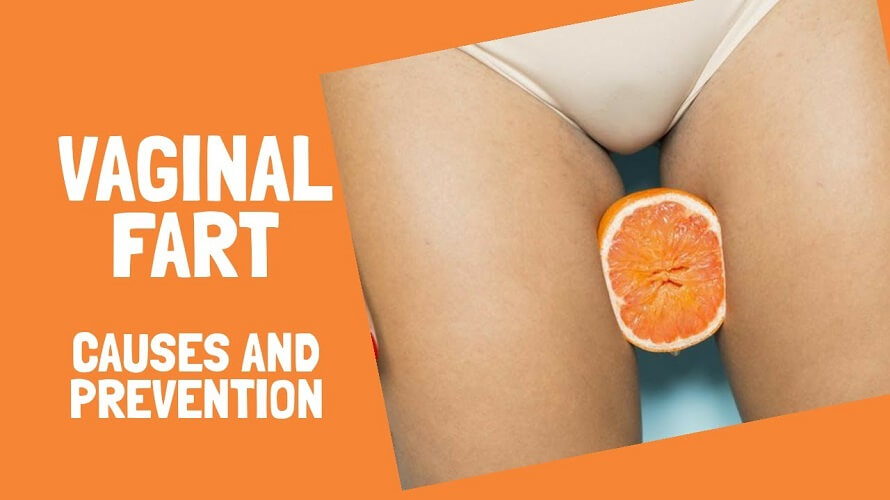Have you ever experienced farts from the vagina?
Do you know what makes flatulence come out of the vagina?
Well, if you do not, we think this is the perfect place for you. We will tell you everything you need to know about farts and whether you need to worry about them or not.
Generally, you might not have to worry about vagina gas but it is important to know about everything.
Let us now get started with our post on flatulence in the vagina.
What Is Vaginal Flatulence?
When the air becomes collected inside the vagina, it causes vaginal gas.
When air is in the cervix, it will finally escape and create a noise identical to ordinary rectum farts.
It’s a common phenomenon, and it’s seldom indicative of a significant health problem. It could, however, be a one-time event or an indication of a medical issue that has to be addressed.
Vaginal flatulence is an instinctive biological activity that develops when accumulated air in the vaginal canal is discharged.
Of course, with a noisy and awkward sound. Vaginal gas has nothing to do with genuine farts, other than the sound.

Have you ever heard the term queefing?
Do you wonder what is queefing (vaginal gas)?
Well, it is nothing but another milder term given to vaginal flatulence.
Queefing is pretty uncommon in typical conditions. The walls of the vaginal canal are muscular and clutched together.
If your pelvis is inclined in a vertical position while shifting postures during intercourse, jogging, or doing yoga, air pockets might still get entrapped inside.
However, after having a kid, queefing might become more regular or even extreme.
There are a variety of explanations why air can become caught in your vagina and cause you to queef or fart through it.
Vaginal flatulence can be caused by a number of different factors. It’s crucial to understand the various causes because some of them require medical attention.
In the next section of the blog, we will look at a few of these factors. We will discuss what causes air in the vagina.
Vaginal Flatulence Causes
Much of the material on vaginal flatulence that has been accumulated — particularly on the internet — is circumstantial, and greater research would certainly provide us with a better knowledge of what makes some women more likely to queef.
With that disclaimer in mind, vaginal flatulence can be caused by a variety of conditions and factors.
A few of them to mention are:
- Sexual Activity
- Pelvic Floor Dysfunction
- Vaginal Fistula
- Feminine Hygiene Products
- Tense Muscles
- Yoga and Exercises
- Medical Procedures
- Child Birth and Labor
These were a few reasons for vaginal air release. But, some of the reasons can be serious.
Mostly the causes are nothing to worry about. Nevertheless, it is essential to address each cause in detail.
That is why we have discussed to ease you as well as warn you about some of the causes of vaginal flatulence.
It is common and not a cause of worry sure, but that does not mean one should ignore vaginal farts if it happens regularly.
We suggest reading the next section of the blog carefully to find the reason behind your farts from the vagina.
-
Sexual Activity
When something is introduced into the vaginal canal, it might cause the air inside to be displaced. This is a common occurrence during mating.
The action of the penis in and out of the vaginal opening might occasionally allow air from entering and become lodged.
The gas is expelled when your muscles strain during a climax or when the penis is withdrawn. This can make a noise and make you feel like you are breathing bubbles.
Gas can also enter the vaginal cavity as a result of oral sex.
Rough sex can create vaginal gases, but it can also lead to an accidental pneumoperitoneum, which is when air builds up and becomes trapped beneath your ribs.
This can result in pain in the chest or upper abdomen.
-
Pelvic Floor Dysfunction

Pelvic floor dysfunction is a catch-all phrase for a variety of problems involving our pelvic floor.
The pelvic floor is a complicated structure containing muscles and tissues that are linked to the vaginal floor.
Some pelvic floor disorders associated with an elevated probability of vaginal gas exists.
The following are some of the most common conditions connected to vaginal gas:
- no control over urine
- Prolapse of the pelvic organs
- incontinence of the bowels
- Childbirth
- being obese
- aging
- prolonged intestinal pressure can all produce weaker pelvic floor muscles.
Vaginal flatulence could indicate a major problem with your pelvic floor.
Therefore, we advise doing regular pelvic floor exercises.
-
Vaginal Fistula
A vaginal fistula is an uncommon reason for vaginal flatulence.
A fistula is an improper connection between the vaginal canal and another organ, such as the bladder, colon, or rectum.
If the fistula is related to the colon or rectum, stool might enter through the vaginal opening.
A fistula can arise as a result of childbirth, cancer treatments, injuries.
Vaginal fistulas come in a variety of shapes and sizes.
These classifications are based on the location of the opening or rupture in the vaginal canal and the organ to which the canal links.
Some different types of Vaginal Fistula are:
- Vesicovaginal Fistula – The opening for a vesicovaginal fistula lies between your urinary bladder and your cervix.
- Ureterovaginal Fistula – A ureterovaginal fistula is a connection between the vagina and the ureter(s), which transport pee from your kidneys to your bladder.
- Rectovaginal fistula – It is a connection between the scrotum and the vagina. This can occur during delivery, pelvic operations, pelvic treatment for cancer, or radiation therapy.
- Enterovaginal Fistula – The small intestine and the vaginal canal form an enterovaginal fistula.
- Colovaginal Fistula – A fistula between the colon and the vaginal canal is known as a colovaginal fistula. Diverticular illness is the most common cause of this type of fistula.
- Urethrovaginal Fistula – A urethrovaginal fistula is a connection between the vagina and the urethra, the channel that transports urine.
-
Hygiene Products
Hygiene products for women that are particularly inserted in them can cause flatulence. It is quite obvious.
This is because when something is inserted like the case during sexual activity air enters.
Whenever air enters it is obvious that it will want some escape from your body. This is what causes vaginal farts.
-
Tense Muscles
When your pelvic muscles are tense, you might feel farts from your vagina.
Your pelvic muscle can become tense during stretching or during coughing or sneezing.
There are other reasons why your pelvic muscles can be tense.
For instance, if you go for a gynecologist examination. Sometimes some medical procedures down there can cause the same.
-
Yoga And Exercises

Yoga and other exercises that stretch the pelvic region often lead the vagina to expand.
This enables more air to pass through. Air held in these pockets might be released unexpectedly with a change in stance or position.
The air might become trapped inside the vaginal canal as a result of exercise movements.
During certain physical activities, such as yoga, women frequently complain vaginal flatulence.
Any workout that stretches out the pelvic area opens and relaxes your vagina, allowing air to pass through.
As a result, you may hear occasional farts while exercising.
-
Medical Procedures
Like said earlier, medical procedures and surgeries might let air enter the body.
During a pelvic check-up, bodily tests and treatments can cause air to enter the cervix. Where it can become retained and then expelled.
Air can become stuck in the vaginal cavity during physical examinations and the induction of a speculum during gynecological exams and other surgeries.
When a doctor pulls the speculum and completes the physical examination, this air may be discharged.
-
Childbirth and Labour

The majority of occurrences of vaginal flatulence in women begin after a normal birth, according to a study published in the journal ISRN Obstetrics and Gynaecology.
As we have said earlier, vagina muscles get tense during normal childbirth.
In fact, during normal delivery, your opening becomes large and might not go back to its normal size.
Hence, you might experience more farts after pregnancy.
These were the reasons behind what causes vaginal flatulence. Vaginal farts are not usually smelly and regular.
However, we suggest you show a medical professional if you get regular and smelly ones.
This was enough of about the causes we feel you should more about how to treat them.
Vaginal Flatulence Treatments

There’s no need to medicate or find a cure for vaginal flatulence because it’s a common occurrence.
However, there are situations when queefing is linked to a medical condition that needs therapy.
By treating the main source of the problem and restoring your pelvic floor health, you can avoid queefing.
You can benefit from the following tips to stop vaginal farting or queefing:
Pelvic Floor Muscles and Tissues Strengthening
Because a weakened pelvic floor is a common cause of pelvic floor dysfunction, concentrating on building it can help your muscles stronger and tissues recover and even enhance their balance.
This can help to strengthen your pelvic organs and increase your pelvic floor’s capacity to tighten and loosen reflexively as needed.
As a result, not only will you be likely to avoid and reduce awkward queefs, but your sex life is also sure to flourish.
- Hypopressives – Hypopressive routines are brief and simple, yet they can cure and prevent even severe pelvic floor dysfunction such as pelvic organ rupture.
- Acupuncture therapies – Acupuncturists can detach pelvic muscles and tissues and softly induce them with pins,
- Collaborating with a pelvic floor physiotherapist – if you would like to contact an expert, consider booking a consultation with a medical professional who specializes in the pelvic floor.
Pelvic Floor Muscles and Tissues Elasticity Improvement
While it’s crucial to build the pelvic floor, you should also include exercises that help you relieve and enhance the elasticity of your pelvic tissues and muscles.
In spite of other perks, this will improve the general functioning of your pelvic floor. It will allow you to avoid queefing.
To name a few, there’s yoga, herb treatment, scar tissue remediation, vaginal steaming, and block therapy.
These will increase adaptability.
Want to know how to stop vaginal flatulence during sex?
Flexibility exercises are your answer.
Developing Better Habits
Boost your pelvic floor wellness and avoid awkward queefing with a healthy lifestyle and nutrition.
Here are a few possibilities to think about:
- Handling or weight loss to relieve overpressure on the pelvic floor,
- ingesting a healthy balanced diet, such as paleo,
- eating foods high in collagen, magnesium, and Vitamin D
- stopping smoking,
- attempting to avoid overly tight garments,
- controlling stress and anxiety, and
- sustaining proper posture while standing, walking, and sitting are all recommended.
These pointers are your answer to “How can I prevent queefing during sex?”
Now we have almost come to the end of our content on vaginal flatulence.
The next section is dedicated to a few frequently asked questions.
Frequently Asked Questions Related To Queefing
What are the vaginal flatulence symptoms?
The symptoms of vaginal flatulence are quite noticeable.
It is simply a fart but from your vagina. It might not be smelly.
However, you will feel like something is coming out of your vagina.
When do you see a doctor?
It’s not necessary to be bothered about vaginal gas produced during sexual intercourse.
It is not an indicator of a medical problem. However, if you are having vaginal gas, you should consult a doctor.
Your doctor can tell you if you have a vaginal fistula or if it’s caused by anything else.
How common is vaginal flatulence?
Vaginal flatulence can affect any woman. However, some data suggest that certain women are more susceptible to it.
For example, a meta-analysis of 15 research on vaginal flatulence discovered that women who had babies vaginally frequently reported vaginal gas thereafter, but this is far from the primary cause of vaginal flatulence.
In Conclusion
There is no true method to deter vaginal gas in many circumstances, but there is also no need to.
The sounds and feeling of trapped air escaping the vagina are usually the sole signs of vaginal gas. It is generally harmless.
Squatting down, especially while peeing, can assist trapped air escape if vaginal gas does not go away eventually.
If your vaginal gas is caused by tension, attempt to relax and practice deep breathing.
When the root issue is addressed, vaginal gas may usually be eradicated.
If a fistula is detected early enough or the hole or tear is small enough, surgery may not be required to treat it. Regardless of the reason, it is critical that you speak with a doctor.

